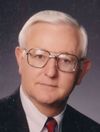Bill St. John (July 27, 1932 – Oct. 26, 2015)
December 8, 2015

Bill St. John, 83, died in Kerrville, Texas on October 26, 2015. He was an extraordinary geologist, widely respected within the petroleum industry where he spent most of his career. His personal pursuit of a greater understanding of what makes the world tick was equally important and respected in academia.
He is survived by his wife of 30 years, Nancy; sons Michael, Tad, Kevin and Doyle; and stepsons Tim and Christopher Rivali.
Billy Eugene St. John was born in Wink, Texas in 1932. He graduated from high school in Wichita Falls and attended Hardin College there but dropped out in the middle of his sophomore year to enlist in the Marines in January 1951. He had stateside training and duties until he got bored and requested a transfer to Korea where he served as a Forward Observer until the truce of July 27, 1953 (his 21st birthday present).
Bill returned to his studies in 1954 when he enrolled at The University of Texas, Austin. He graduated with a BS in Geology in June 1958. With the encouragement of Dr. Bill Muehlberger, Bill remained in school and received an MA in Geology in June 1960.
He worked briefly for the Bureau of Economic Geology in Austin before accepting an offer from Amoseas to work in Libya where his geological acumen and willingness to stand up to whatever came along was typified. One of his first assignments was to do field work alongside a seismograph crew. They had set up camp in a valley which Bill immediately recognized as a breached anticline. Bill requested aerial photos, mapped it, measured sections and prepared a report. The General Manager doubted that a fresh-faced new kid could have done that by himself and asked Bill whose work he had copied. Bill got angry, told the Manager what he thought, what the Manager could do and walked out. Maybe that’s why a few years later he quit and went back to UT to pursue a Ph.D. His dissertation work was in the Black Gap area of the eastern Big Bend, West Texas; again under the guidance of Dr. Muehlberger.
Upon receipt of his Ph.D. in 1965 Bill took a job with Esso Exploration. He was with them for eight years, mostly in Stavanger, Norway and at Esso Production Research in Houston. He then had an opportunity to work for a very small independent, LVO. While there from 1973-81, his interest in exotic places led him to generate or support proposals in Africa, the Middle East and Southeast Asia. That was followed by an opportunity to lead another small company, Primary Fuels. Under his leadership it grew from virtually nothing to an attractive, successful, takeover target in 1989.
Bill then hung out his consulting shingle. In 1990 he accepted a request by the World Bank to oversee a project intended to promote the petroleum potential of Ethiopia. He prepared a well-documented report demonstrating that potential, particularly within the Ogaden Basin bordering Somalia. His report was quite successful as it led to interest by several companies and large concessions were subsequently taken by Maxus Energy and Hunt Oil. Early on, Bill accompanied Maxus personnel on a helicopter overflight of their concession area. The pilot inadvertently landed in a small town in Somalia. All personnel were taken into custody as possible CIA, or even Israeli, spies. They were flown to Mogadishu and placed under house arrest before being released eight days later. Meanwhile Bill had signed on as Resident Manager for Hunt Oil’s concession. Life in Ethiopia included a fair share of interesting experiences such as running through a barricade set up by armed bandits, an evacuation due to a rebel insurgency and constant personal and company logistical problems. In 1994 Bill took Nancy’s advice, resigned from Hunt Oil and returned to the USA. Shortly thereafter, Hunt Oil requested that Bill return to restore government relations that had seriously deteriorated under his successor. By 1995 that had been accomplished and thus ended the Ethiopian saga.
By then Bill had a well-deserved reputation as one of the very best analysts of the prospectivity of relatively untested basins. He was called upon to work on basins in India, Azerbaijan and a wide range of African countries. He accepted one long-term assignment with Vanco Energy to study the West African offshore; no small feat in itself. In fact, large scale projects were right down his alley as he was, quite literally, always ready to take on the world. In his ‘spare’ time in 1984 he created the still popular map Sedimentary Provinces of the World which is also now available in digital format from the AAPG. Also in 1984 he was program chair for the Wallace E. Pratt Memorial Conference, Future Petroleum Provinces of the World, the proceedings of which were published in 1986 as AAPG Memoir 40. Bill authored/co-authored two contributions to that volume, on Antarctica and on giant oil and gas fields. In 1990 Bill was editor of AAPG Studies in Geology No. 31, Antarctica as an Exploration Frontier: Hydrocarbon Potential, Geology and Hazards. By mid-2010 he had authored and self-published the well-received Hydrocarbon Potential of the Eastern Africa Offshore. At the time of his death he was working on a Tectonic Map of the World; no small undertaking for one person.
George Bernard Shaw wrote it: “Some men see things as they are and ask ‘why?’. Others dream things that never were and ask ‘why not?’” Teddy Kennedy popularized it in a memorial service for his brother Bobby in 1968. Bill lived it. He will be greatly missed.
Contributed by Patricia Wood Dickerson and Ted Schulenberg
Back to the Newsletter